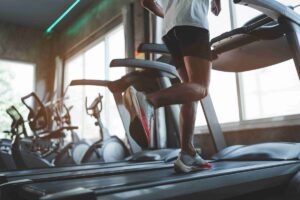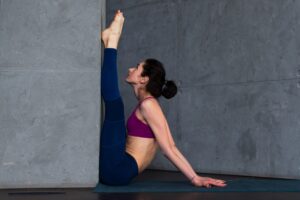The importance of warming up, according to experts

If you’re new to exercise, stretching before you get
into your session can feel a hindrance. But you’ll quickly learn the importance
of warming up when you wake up the day after a tough workout.
You might be eager to start, but a nasty spell
of DOMS will set you back further than a few minutes
of preparing your body for exercise.
Here you’ll find expert insights on the benefits of warming up and suggestions to try out before your next session.
Table of contents
Why is warming up so important?
Warming up has many physical and mental benefits,
the main one being injury prevention so you can stay motivated and keep hitting
your fitness goals. Gabrielle Watkins, Personal Trainer at OriGym, explains:
“Warming up helps to increase your heart rate and blood flow, allowing more oxygen to travel to your muscles.
In turn, this will make the workout ahead less strenuous, as these muscles will now be able to contract and relax easily—decreasing the risk of injuries.”
That said, it isn’t always easy to structure a
warm-up routine to reap these benefits if you haven’t done so before.
We’ve got some specific exercise suggestions below,
but knowing how to format these stretches is imperative for preparing your body
and mind ahead of a workout.
According to Mitch Raynsford, Strength &
Conditioning Coach at P3RFORM, following a RAMP
protocol can ensure you have ticked off all the boxes ready for your session:
R = raise the body temperature, heart and respiration rate, joint fluid viscosity and blood flow to work muscles.
AM = activate key muscle groups and mobilise the joints through the full range of motion during the upcoming exercise.
P = potentiate subsequent performance with post-activation potentiation, e.g., maximal jumps to increase acceleration.
Suppose you’re an aspiring athlete or have specific
goals to hit through your training. Warming up becomes more than avoiding
injury and getting into the right mindset. In that case, it can directly impact
your performance.
You can learn more about post-activation potentiation here, which could help you reach your goals faster, whether you’re aiming to up your deadlift PB or your road cycling sprints.
The most effective stretches for preventing injuries
Now you know the importance of warming up, it’s
natural to wonder which stretches are the best for avoiding injury and ensuring
you get the most out of your workout.
Matt Hodges, Personal Trainer and founder of The MPH Method, explains:
“There is no one that fits all—it depends on the exercise or sport. It’s safe to say that dynamic and movement stretches would be more beneficial than static stretches before a workout, and vice versa.”
Dynamic stretches protect your muscles and joints by
working them through their full range of motion.
Regular practice boosts your flexibility and
mobility, which is hugely important for staying on top form and preventing
injury.
Fortunately, there are many dynamic warm-up routines for you to
follow if you’re a beginner. You can quickly Google the best
dynamic stretches for (insert activity here) to find those
most effective for your workout.
If you’re stuck for inspiration, try Strength and Conditioning expert Mitch Raynsford’s go-to full-body warm-up exercises:
1. World’s greatest stretch
How-to:
start in the high plank position—your hands should be around shoulder-width apart, and your feet in line with your glutes bring your right foot forward, and rest it alongside your right hand—keep your back straight and your neck in line with your spinetuck your right elbow into your right ankle—inhale before completing the next movement bring your right arm up behind your back—carefully rotate your body out as you do so, exhaling gradually return to the starting position—take a moment, then repeat with the left side of your body
Reps/sets: 5-10 reps, 1-3 sets
2. Thoracic reach throughs
How-to:
begin on your hands and knees—your hands should be around shoulder-width apart and your knees in line with your hipsbring your right arm between your left arm and knee—carefully rotate your upper body inwards as you do so, keeping your hips stable place your right shoulder on the floor—you should feel a slight pressure in your shoulder jointhold for a second, then repeat on your left side—carefully reach your left arm between your right arm and knee this time, applying slight pressure to your left shoulder joint
Reps/sets: 5-10 reps, 1-3 sets
3. Adductor rock backs
How-to:
begin on your hands and knees—your hands should be around shoulder-width apart and your knees in line with your hipsstretch your right leg out to the side—ensure it’s at a 45-degree angle about your left kneecarefully rock back using your hands as the driving force—keep your core engaged and your back straight as you do sostop when you feel a slight pressure in your groin—slowly rock forwards again once you feel your groin being stretched to avoid overstretchingrepeat with your left leg once you’ve completed your set—keep everything nice and slow, and gradually push yourself further back as long as you don’t feel too much pressure
Reps/sets: 5-10 reps, 1-3 sets
4. Curtsey lunges
How-to:
stand with your feet hip-width apart—you can either have your hands on your hips or out at your sides to help you balance through the movement step back with your right leg—it should cross behind your left leg, and your toes on both feet should be nicely aligned as your right knee bends towards the floor drive back up into the starting position—avoid using too much momentum as you repeat the movement with your left leg
NOTE: avoid
placing too much stress on the knees during this movement by keeping your back
foot in a stable position that isn’t too far out to the side.
Reps/sets: 5-10 reps, 2-3 sets
5. Counter movement jumps
How-to:
begin with your feet around shoulder-width apart—stand tall with your back straight, neck in line with your spine, and your arms in the air bend your knees before driving yourself into the air through your heels—swing your arms downwards and then swiftly upwards as you do so, and keep your body as streamlined as possible to control the movement land with your knees bent and your arms behind your back—this avoids placing any pressure on your knee joints or ankles
Reps/sets: 5-10 reps, 2-3 sets
Related: 9 injury prevention exercises to improve your performance
How long should you warm up?
“The advised warm-up time ranges between 5-10 minutes and should include light aerobic activity and some form of dynamic stretching,” says OriGym Personal Trainer Gabrielle Watkins.
“The total time can vary from one athlete to another and should be done until you feel adequately prepared for the workout ahead.”
Whatever your time constraints, remember to follow the RAMP protocol shared by Raynsford—raise, activate, mobilise, and potentiate.
Should you warm up differently depending on the exercise you’re doing?
We’ve touched on this already, but what is the true
importance of warming up in a way specific to your training?
Is it as simple as choosing dynamic over static
stretches, or should you choose different exercises depending on your training
style?
“This is somewhat subjective to which coach you talk to. I’m a fan of what I call ‘applied’ warm-ups. This means warming up the muscles for the actions that will be asked of the muscle”, says Matt Hodges.
“For instance—if I’m asking a client to squat or deadlift, I’ll focus more on mobilising and warming up the glutes and ankles. If I were taking a client through a run-of-the-mill metabolic session, a more dynamic full-body approach would be taken.”
If you want to get the most out of each session,
Hodges recommends keeping your warm-ups relevant to your goal for that
workout.
“The best bet is to keep the warm-up specific to what you will focus on in the session. There’s no point spending huge amounts of time warming up the neck if you’re about to go cycling.”
How important is cooling down after exercise?
Once you’ve understood the importance of warming up
before exercise, it also pays to allow your body to recover properly before
taking a break.
“Cooling down after your workout has proven to
benefit the body and prevent ailments such as light-headedness.
This process ensures that your heart rate and blood
pressure gradually returns to the regular pace, rather than drastically
dropping should you stop exercising altogether,” says Watkins.
Like warming up, you can maximise your recovery by carefully choosing your exercises. To do so, Hodges suggests working the muscles you’ve targeted throughout your workout to a lesser extent:
“Cooling down can come in many forms. Relaxing, cold water therapy, higher reps/lower weight etc. I always do ‘deload’ sets with clients on the bigger lifts, and maybe some rehabilitative stretching post-workout”.
Whether you’re a gym member, an athlete, or part of a competitive sports team, you may want to protect yourself through specialist sports
insurance.
Unfortunately, most sports and physical activities
come with the risk of suffering an injury that could not only pause your
training but also affect your ability to work and earn a living for a period.
At Insure4Sport, you can opt for Personal Accident
and Loss of Earnings cover to help with unexpected costs, and give you peace of
mind in the worst-case scenarios.
Learn more about how we can help here, or click the banner below to get an instant online quote.






